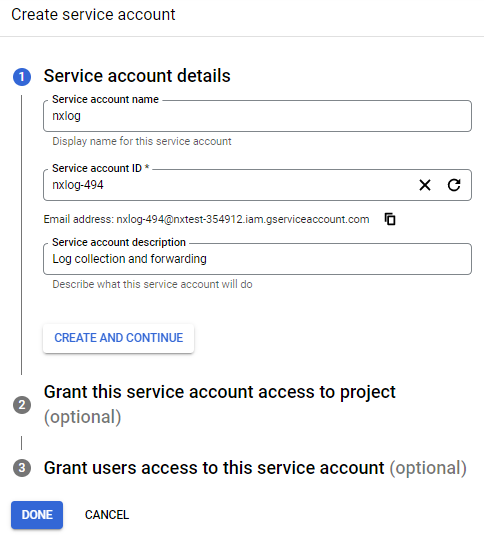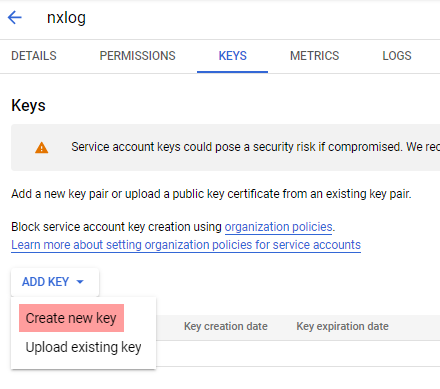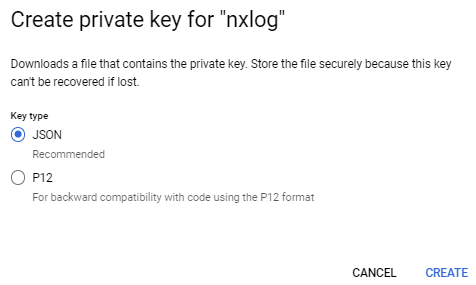Google Cloud Pub/Sub (im_googlepubsub)
Google Cloud Pub/Sub is a service that allows event producers to deliver events to subscribers asynchronously. It is commonly used for data streaming, real-time event distribution, or as a message queue for parallel workflows.
This module uses the Google Pub/Sub REST API to create a subscription and collect logs from a Google Pub/Sub topic.
| To examine the supported platforms, see the list of installer packages in the Available Modules chapter. |
Configuring a Google Cloud service account
om_googlelogging requires a Google Cloud service account and a corresponding private key file in JSON format to connect to the Cloud Logging API. Follow these instructions to create a new service account and download its private key file for an existing project.
-
Log in to your Google Cloud account and switch to the project you want to configure.
-
From the navigation menu, click on IAM & Admin > Service Accounts.

-
Click CREATE SERVICE ACCOUNT.
-
Enter a service account name and description and click CREATE AND CONTINUE.

-
Select the Owner role from the Role drop-down and click DONE.

-
Click on the newly created account on the Service accounts page to open its configuration page.
-
Click the KEYS tab, expand the ADD KEY drop-down and select Create new key.

-
Select JSON for the key type and click CREATE to download the private key. Save the private key file to a location accessible by NXLog. This file is required for the NXLog configuration.

Configuration
The im_googlepubsub module accepts the following directives in addition to the common module directives. The CredentialsFile and Subscription directives are required.
- CredentialsFile
-
This mandatory directive specifies the path to the private key file of the service account required for authenticating with the Google Pub/Sub. See Configuring a Google Cloud service account for more information.
- Subscription
-
This mandatory directive specifies the name of the subscription from which messages should be pulled. The format is
projects/{project}/subscriptions/{sub}.
- Acknowledge
-
This optional boolean directive specifies whether an acknowledge confirmation should be sent for received messages. The default is
TRUE.
- CADir
-
This directive specifies a path to a directory containing certificate authority (CA) certificates. These certificates will be used to verify the certificate presented by the remote server. The certificate files must be named using the OpenSSL hashed format, i.e. the hash of the certificate followed by .0, .1 etc. To find the hash of a certificate using OpenSSL:
$ openssl x509 -hash -noout -in ca.crtFor example, if the certificate hash is
e2f14e4a, then the certificate filename should bee2f14e4a.0. If there is another certificate with the same hash then it should be namede2f14e4a.1and so on.A remote server’s self-signed certificate (which is not signed by a CA) can also be trusted by including a copy of the certificate in this directory.
The default operating system root certificate store will be used if this directive is not specified. Unix-like operating systems commonly store root certificates in
/etc/ssl/certs. Windows operating systems use the Windows Certificate Store, while macOS uses the Keychain Access Application as the default certificate store. See NXLog TLS/SSL configuration in the User Guide for more information on using this directive.
- Connections
-
Number of allowed parallel HTTP connections. The default is 1.
- PollInterval
-
This directive specifies how frequently the module will check for new events in seconds. If this directive is not specified, it defaults to 20 seconds.
- Reconnect
-
This optional directive sets the reconnect interval in seconds. If it is set, the module attempts to reconnect in every defined second. If it is not set, the reconnect interval will start at 1 second and doubles on every attempt. If the duration of the successful connection is greater than the current reconnect interval, then the reconnect interval will be reset to 1 sec.
- ReadFromLast
-
This optional boolean directive instructs the module to only read logs that arrive after NXLog is started. This directive is not normally required if the Acknowledge directive is set to 'TRUE' (default) as the Google Cloud Pub/Sub server will manage the starting point when a connection is (re-)established. This directive comes into effect if a saved position is not found, for example on first start, or when the SavePos directive is
FALSE. When the SavePos directive isTRUEand a previously saved position is found, the module will always resume reading from the saved position. If ReadFromLast isFALSE, the module will read all the available logs. This can result in a lot of messages and is usually not the expected behavior. For this to has effect the subscription needs to have "Retain acknowledged messages" option activated. If this directive is not specified, it defaults toTRUE.The following matrix shows the outcome of this directive in conjunction with the SavePos directive:
ReadFromLast SavePos Saved Position Outcome TRUETRUENo
Reads events that are logged after NXLog is started.
TRUETRUEYes
Reads events from saved position.
TRUEFALSENo
Reads events that are logged after NXLog is started.
TRUEFALSEYes
Reads events that are logged after NXLog is started.
FALSETRUENo
Reads all events.
FALSETRUEYes
Reads events from saved position.
FALSEFALSENo
Reads all events.
FALSEFALSEYes
Reads all events.
- SavePos
-
If this boolean directive is set to
TRUE, the timestamp of the last read event will be saved when NXLog exits. This directive is not normally required if the Acknowledge directive is set to 'TRUE' (default) as the Google Cloud Pub/Sub server will manage the starting point when a connection is (re-)established. The timestamp will be read from the cache file upon startup. For this to has effect the subscription needs to have "Retain acknowledged messages" option activated. The default isTRUE, the last timestamp will be saved if this directive is not specified. This directive affects the outcome of the ReadFromLast directive. The SavePos directive can be overridden by the global NoCache directive.
- URL
-
Optional directive for specifying a region-specific URL. The default is
https://pubsub.googleapis.com.
Fields
The following fields are used by im_googlepubsub.
$raw_event(type: string)-
A list of event fields in key-value pairs.
$Attributes.*(type: string)-
Attributes for this message. It contains user-defined keys.
$Data(type: string)-
The message data field.
$MessageId(type: string)-
ID of this message, assigned by the server when the message is published.
$OrderingKey(type: string)-
If non-empty, identifies related messages for which publish order should be respected. If a Subscription has enableMessageOrdering set to true, messages published with the same non-empty orderingKey value will be delivered to subscribers in the order in which they are received by the Pub/Sub system.
$PublishTime(type: datetime)-
The time at which the message was published, populated by the server when it receives the topics.publish call.
Examples
This configuration uses the im_googlepubsub input module to create the subscription test and collect logs from the Google Cloud project myproject.
<Input google_pubsub>
Module im_googlepubsub
CredentialsFile /path/to/credentials.json (1)
Subscription projects/myproject-343509/subscriptions/test
</Input>| 1 | Credentials file for authenticating with the Google Pub/Sub. See Configuring a Google Cloud service account for more information. |

